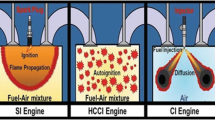Abstract
Although premixed charge compression ignition (PCCI) combustion engines are praised for potentially high efficiency and clean exhaust, experimental engines built to date emit more hydrocarbons (HCs) and carbon monoxide (CO) than the conventional machines. These compounds are not only strictly controlled components of the exhaust gas of road vehicles but are also an energy loss indicator. The prime objective of this study was to investigate the major sources of the HCs formed in the combustion chamber of an experimental PCCI engine in order to suggest some effective technologies for HC reduction. In this study, to explore the dominant sources of HC emissions in both operation modes, a single cylinder engine was prepared such that it could operate using either conventional diesel combustion or PCCI combustion. Specifically, the contributions of the top-ring crevice volume in the combustion chamber and the bulk quenching of the lean mixture were investigated. To understand the influence of the shape and magnitude of the crevice on HC emissions, the engine was operated with 12 specially prepared pistons with different top-ring crevices installed one after another. The engine emitted proportionally more HCs as the depth of the crevice increased as long as the width remained narrower than the prevailing quench distance. The top-ring-crevice-originated exhaust HCs comprised approximately 31% of the total HC emissions in the baseline condition. In a series of tests to estimate the effects of bulk quench on exhaust HC emissions, intake air was heated from 300K to 400K in steps of 25K. With the intake air heated, HC and CO emissions decreased with a gradually diminishing rate to zero at 375K. In conclusion, the most dominant sources of HC emissions in PCCI engines were the crevice volumes in the combustion chamber and the bulk quenching of the lean mixtures. The key methods for reducing HC emissions in PCCI engines are minimizing crevice volume in the combustion chamber and maximizing intake air temperature allowed based on the permissible NOx level.
Similar content being viewed by others

References
Alkidas, A. C. (1999). Combustion-chamber crevices: The major source of engine-out hydrocarbon emissions under fully warmed conditions. Progress in Energy and Combustion Science 25,3, 253–273.
Bae, C. S. (2003). Diesel-fueled HCCI engines and alternative fuel. J. Korean Society of Automotive E 25,5, 10–14.
Cheng, W. K., Hamrin, D., Heywood, J. B., Hochgreb, S., Min, K. D. and Norris, M. (1993). An overview of hydrocarbon emissions mechanisms in spark-ignition engines. SAE Paper No. 932708.
Christensen, M. and Johansson, B. (2001). The effect of piston topland geometry on emissions of unburned hydrocarbons from a homogeneous charge compression ignition (HCCI) engine. SAE Paper No. 2001-01-1893.
Cleary, D. J. and Farrell, P. V. (1995). Single-surface flame quenching distance dependence on wall temperature, quenching geometry, and turbulence. SAE Paper No. 950162.
Gray III, A. W. and Ryan III, T. W. (1997). Homogeneous charge compression ignition (HCCI) of diesel fuel. SAE Paper No. 971676
Hackert, C. L., Ellzey, J. L. and Ezekoye, O. A. (1998). Effects of thermal boundary conditions of flame shape and quenching in ducts. Combustion and Flame, 112, 73–84.
Hasse, C. and Peters, N. (2000). Differences between ISO-octane and methane during wall quenching with respect to HC emissions. SAE Paper No. 2000-01-2807.
Iwabuchi, Y., Kawai, K., Shoji, T. and Takeda, Y. (1999). Trial of new concept diesel combustion system — Premixed compression-ignited combustion —. SAE Paper No. 1999-01-0185.
Jung, G. S., Kim, H. N., Sung, Y. H., Choi, B. C. and Lim, M. T. (2006). Performance characteristics of diesel oxidation catalysts designed for low temperature exhaust gas of HCCI engine. Spring Conf. Proc., Korean Society of Automotive of Engineeres, KSAE Paper No. 06-S0055. 340-345.
Jung, G. S., Sung, Y. H., Kang, H. Y., Choi, B. C. and Lim, M. T. (2006). HCCI combustion and exhaust emission of DME in a rapid compression and expansion machine. 3rd Asian DME Conf., 399–405.
Kim, C. G., Bae, C. S. and Choi, S. M. (1998). Effect of gas flow through the inter-ring crevice on UHC emission. Fall Conf. Proc., Korean Society of Automotive of Engineeres, KSAE Paper No. 98380771, 166–171.
Lee, C. H. and Lee, K. H. (2006). Experimental study on the stratified combustion characteristics according to compression ratio and intake temperature in a DIG engine. Int. J. Automotive Technology 7,6, 675–680.
Namazian, M. and Heywood, J. B. (1982). Flow in the piston-cylinder-ring crevices of a spark-ignition engine: Effect on hydrocarbon emissions, efficiency and power. SAE Paper No. 820088.
Thring, R. H. (1989). Homogeneous — charge compression — ignition (HCCI) engine. SAE Paper No. 892068.
Tsurushima, T., Harada, A., Iwashiro, Y., Enomoto, Y., Asaumi, Y. and Aoyagi, Y. (2001). Thermodynamic characteristics of premixed compression ignition combustions. SAE Paper No. 2001-01-1891.
Author information
Authors and Affiliations
Corresponding author
Rights and permissions
About this article
Cite this article
Jung, G.S., Sung, Y.H., Choi, B.C. et al. Major sources of hydrocarbon emissions in a premixed charge compression ignition engine. Int.J Automot. Technol. 13, 347–353 (2012). https://doi.org/10.1007/s12239-012-0032-5
Received:
Revised:
Accepted:
Published:
Issue Date:
DOI: https://doi.org/10.1007/s12239-012-0032-5



